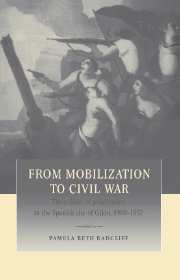Book contents
- Frontmatter
- Contents
- List of maps
- List of tables
- Acknowledgments
- Glossary of terms and abbreviations
- Introduction
- 1 A turning point: the city in 1900
- PART I Patterns of life in working-class Gijón
- PART II Institutional forces of opposition: republicans and anarchosyndicalists
- PART III Defining an oppositional culture: the struggle over the public sphere
- PART IV The urban battlefield: conflict and collective action, 1901–1936
- Conclusion
- Appendix 1 Wage and price movement
- Appendix 2 Occupations by status category
- Appendix 3 Supplementary tables
- Select bibliography
- Index
1 - A turning point: the city in 1900
Published online by Cambridge University Press: 31 October 2009
- Frontmatter
- Contents
- List of maps
- List of tables
- Acknowledgments
- Glossary of terms and abbreviations
- Introduction
- 1 A turning point: the city in 1900
- PART I Patterns of life in working-class Gijón
- PART II Institutional forces of opposition: republicans and anarchosyndicalists
- PART III Defining an oppositional culture: the struggle over the public sphere
- PART IV The urban battlefield: conflict and collective action, 1901–1936
- Conclusion
- Appendix 1 Wage and price movement
- Appendix 2 Occupations by status category
- Appendix 3 Supplementary tables
- Select bibliography
- Index
Summary
At the onset of the twentieth century, Gijón's fortunes seemed to be directly opposed to those of the rest of the country. As Spain sagged under the weight of military defeat and economic crisis, Gijón was poised for industrial take-off. The war with the United States that brought an inglorious end to Spain's coveted imperial identity had a quite different effect in Gijón. A wave of repatriated capital from Asturians in the colonies created an unparalleled growth spurt that put the province and its major industrial city on the map.
Asturias is in fashion. All the newspapers speak of an Asturian economic renaissance that will lead to a national renaissance … Individual initiative in work has increased greatly in Asturias, and in it we see the remedy for the great damage caused by general inaction and weakness.
In this heady atmosphere, many people believed not only that Asturias would take its place as the newest industrial region, after Catalonia and the Basque country, but that it would assist in sparking a national recovery. Thus, while the nation plunged into pessimistic analysis of its decline, Asturias radiated success.
Despite the apparent uniqueness of the regional and local trajectory of development, the fin de siècle marked a similar turning point for both city and nation. In stark terms, it signaled a hegemonic break, the beginning of a long-term crisis of authority that would only be resolved on the battlefield of the Civil War, several decades later.
- Type
- Chapter
- Information
- From Mobilization to Civil WarThe Politics of Polarization in the Spanish City of Gijón, 1900–1937, pp. 16 - 58Publisher: Cambridge University PressPrint publication year: 1997

